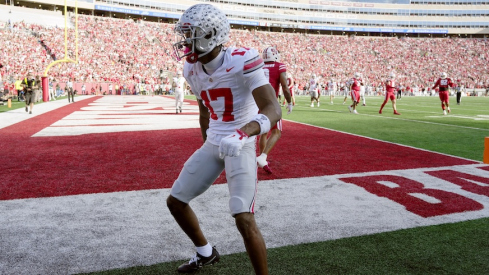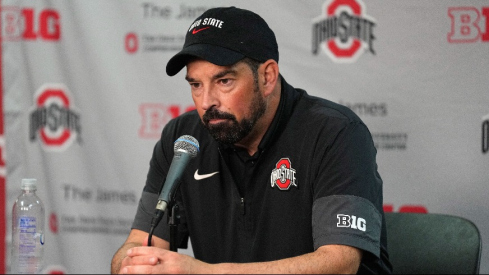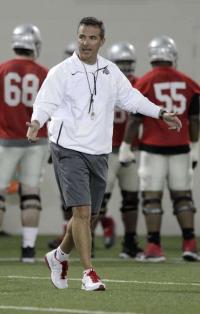 My Way.
My Way.Ohio State's spring football is providing the first glimpses at the Urban Meyer Ohio State offense. The upshot? It looks very much like Urban Meyer's offense at the end of his Florida tenure. Indeed, much of the terminology dates to Meyer's Utah days. The Ohio State offense clearly reflects Meyer's offensive tenets; namely a one-back power run and play-action game from the shotgun, sprinkled with reads and option football. (Disclaimer: As I only saw one scrimmage, the offensive staff may have featured certain concepts as a means to work on them while de-emphasizing others).
Formation and Alignment
The OSU offense was nearly entirely no-huddle. They were also almost entirely in shotgun. The only time OSU huddled was in short yardage and goal line situations. They would do a quick huddle, sprint to the line in an offset-I and quick snap to run power. Otherwise it was all no-huddle and shotgun. Similar to as described here, four different individuals were charged with providing the no-huddle hand signals. The Buckeyes primarily used '11' personnel (3 WR, 1 RB, 1 TE). The H-Back would line up in a 'hip' position splitting the tackle's outside leg. The most frequent look was what Smart Football's Chris Brown diagrammed below (absent the pre-snap motion).
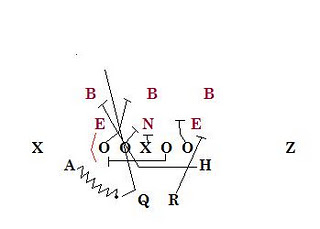
The Buckeye receivers were either in doubles or tight trips. Generally, the halfback lined up opposite the tight end. OSU also showed a look where the tailback would start in the pistol position, then on the QB's clap he would move to a halfback position and chop his feet until the snap.
The Run and Play-Action Game
The majority of scrimmage was focused upon the run and play-action game. The run game looked similar to Meyer's late Florida offense. Indeed, the video clips from Florida's 2008 team below looks like much of what Ohio State's 2012 squad displayed. The primary difference is that OSU is (obviously) not going to run Braxton Miller inside like Tim Tebow. Instead, OSU's tailbacks are charged with running between the tackles, with Miller attacking the edges with option off the inside run action.
OSU featured inside zone read, counter trey, power, and speed option. The inside zone looks exactly as diagrammed from the 2008 Florida spring clinic. The halfback attacks the center's back leg, making it look more like a dive than zone run. (:31 second mark).
At times, the slot receiver would come in motion in the backfield and run a pitch option off the zone. (2:21 mark).
Counter trey was the most frequently run play. Meyer being Meyer, OSU used numerous looks to achieve the same blocking scheme. The Buckeyes would run it away from the halfback, with the back following the pulling guards (5:12 above). They would also run it towards the halfback's side, with the halfback taking a counter step and then coming back to the play (as diagrammed above). Finally, OSU would run counter trey action away from the back and towards the QB, but hand-off on the read away from counter action (3:47 mark). As with zone, the Buckeyesalso ran option off the counter-trey fake. (4:19). The same principle applies with power. (3:39). OSU also sprinkled in outside zone and inverted veer. These six plays form the basis for Ohio State's run game.
The name of the game for Meyer is constraint. The base plays are typical of a pro-style run game, but the shotgun and option provides ways to constrain the unblocked backside defenders and not let the defense key. The QB read is one way to do this, as is the backside option off the initial inside run fake. So is running counter trey both to and away from the HB, as well as running it away from the trey action as a false key. Meyer is constantly searching for ways to prevent a defense to get a pre-snap read and cheat against his bread and butter plays.
Perhaps the best example was the constraint for speed option. Speed option is an inexpensive way to attack the perimeter, but the action indicates to the defense where the play is going. OSU therefore ran a reverse off that action, where the slot receiver cut between the option relationship and received the pitch from the QB. Meyer is therefore always looking for ways to keep the defense honest for the base inside power game.
Play Action
Meyer's constraint focus is also evident in the play action philosophy. As Meyer announced at the 2008 Florida Spring Clinic, every run play must have a complimentary pass play.
The most prevalent play-action look was the waggle diagrammed here. The backside guard would pull away from run action and allow the QB to set in the pocket. OSU also ran a naked rollout backside away from the counter-trey action. These plays would be combined with a mixture of flood and/or pivot routes. The Buckeyes also displayed quick stick routes off inside zone action to the H-Back.
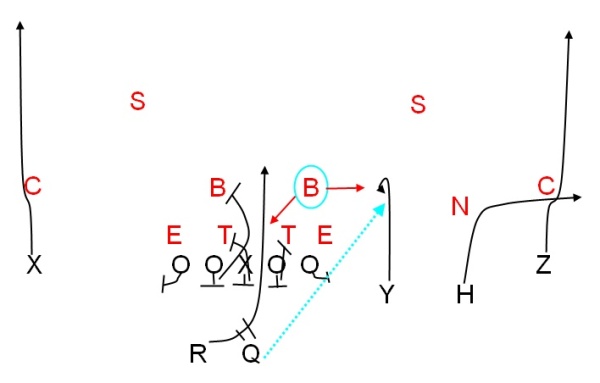
Finally, OSU features trademarks of Meyer and Tom Herman, respectively. For Meyer, it was the inside shovel pass off option action. For Herman, it is the flash screen (known as "Lexus"). OSU demonstrated plenty of the latter, showing this will be an important constraint play for OSU this season.
The OSU run and play-action game was prototypical Meyer. The system's base is the inside power run game. But the shotgun QB run and option threat provides the offense opportunities to constrain the defense and attack the perimeter. Every base play has a read, a counter, and perhaps a counter to that counter. This fits well with OSU's personnel, which features tough inside running tailbacks, and a quarterback that is dynamic when he gets outside. In part II I will focus on pass game concepts.
Bonus: Bank and Boulder on OSU's Personnel
I was fortunate to get the opportunity to take in practice with Scout.com's Bill Greene. Below, Bill and I offer our takes on Ohio State's personnel following spring practice.
